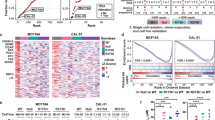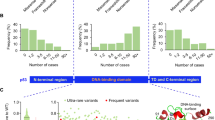Abstract
We report that the expression of murine or human mutant p53 proteins in cells with no endogenous p53 proteins confers new or additional phenotypes upon these cells. Mutant p53 proteins expressed in cell lines lacking p53 resulted in either enhanced tumorigenic potential in nude mice ((10)3 cells) or enhanced plating efficiency in agar cell culture (human SAOS–2 cells). Also, mutant human p53 alleles, unlike the wild–type p53 protein, could also enhance the expression of a test gene regulated by the multi–drug resistance enhancer–promoter element. These data demonstrate a gain of function associated with p53 mutations in addition to the loss of function shown previously to be associated with mutations in this tumour suppressor gene.
This is a preview of subscription content, access via your institution
Access options
Subscribe to this journal
Receive 12 print issues and online access
$209.00 per year
only $17.42 per issue
Buy this article
- Purchase on SpringerLink
- Instant access to full article PDF
Prices may be subject to local taxes which are calculated during checkout
Similar content being viewed by others
References
Johnson, P. & Benchimol, S. Friend virus induced murine erythroleukaemia: The p53 locus, in Cancer Surveys 12, (ed. A.J. Levine) 137–151 (Cold Spring Harbor Press, New York, 1992).
Baker, S.J. et al. Chromosome 17 deletions and p53 gene mutations in colorectal carcinoma. Science 244, 217–221 (1989).
Baker, S.J., Markowitz, S., Fearon, E.R., Willson, J.K.U. & Vogelstein, B. Suppression of human colorectal carcinoma cell growth by wild-type p53. Science 249, 912–915 (1990).
Finlay, C.A., Hinds, P.W. & Levine, A.J. The p53 proto-oncogene can act as a suppressor of transformation. Cell 57, 1083–1093 (1989).
Chen, P.-L., Chen, Y., Bookstein, R. & Lee, W.-H. Genetic mechanisms of tumour suppression by the human p53 gene. Science 250, 1576–1579 (1990).
Farmer, G.E. et al. Wild-type p53 activates transcription in vitro. Nature 358, 83–86 (1992).
Kern, S. et al. Oncogenic forms of p53 inhibit p53-regulated gene expression. Science 256, 827–32 (1992).
Zambetti, G.P., Bargonetti, J., Walker, K., Prives, C. & Levine, A.J. Wild-type p53 mediates positive regulation of gene expression through a specific DNA sequence element. Genes Dev. 6, 1143–1152 (1992).
Bargonetti, J., Friedman, P.N., Kern, S.E., Vogelstein, B. & Prives, C. Wild-type but not mutant p53 immunopurified proteins bind to sequences adjacent to the SV40 origin of replication. Cell 65, 1083–1091 (1991).
El-Deiry, W.S., Kern, S.E., Pietenpol, J.A., Kinzler, K.W. & Vogelstein, B. Definition of a consensus binding site for p53. Nature Genet. 1, 45–49 (1992).
Funk, W.D. et al. A transcriptionally active DNA-binding site for human p53 protein complexes. Molec. cell. Biol. 12, 2866–2871 (1992).
Kern, S.E. et al. Identification of p53 as a sequence-specific DNA-binding protein. Science 252, 1708–1711 (1991).
Barnonetti, J. et al. Site-specific binding of wild-type p53 to cellular DMA is inhibited by SV40 T antigen and mutant p53. Genes Dev. 6, 1886–1898 (1992).
Levine, A.J., Momand, J. & Finlay, C.A. The p53 tumour suppressor gene. Nature 351, 453–456 (1991).
Hollstein, M., Sidransky, D., Vogelstein, B. & Harris, C.C. p53 mutations in human cancers. Science 253, 49–53 (1991).
Kern, S.E. et al. Mutant p53 proteins bind DNA abnormally in vitro. Oncogene 6, 131–136 (1991).
Mietz, J.A., Unger, T., Huibregtse, J.M. & Howley, P.M. The transcriptional transactivation function of wild-type p53 is inhibited by SV40 large T-antigen and by HPV-16 E6 oncoprotein. EMBO J. 11, 5013–5020 (1992).
Yew, P.R. & Berk, A.J. Inhibition of p53 transactivat ion required for transformation by adenovirus E1B 55 Kd protein. Nature 357, 82–85 (1992).
Momand, J., Zambetti, G.P., Olson, D.C., George, D. & Levine, A.J. The mdm-2 oncogene product forms a complex with the p53 protein and inhibits p53 mediated transactivation. Cell 69, 1237–1245 (1992).
Zambetti, G.P., Olson, D., Labow, M. & Levine, A.J. A mutant p53 protein is required for the maintenance of the transformed cell phenotype in p53 plus ras transformed cells. Proc. natn. Acad. Sci. U.S.A. 89, 3952–3956 (1992).
Martinez, J., Georgoff, I., Martinez, J. & Levine, A.J. Cellular localization and cell cycle regulation by a temperature sensitive p53 protein. Genes Dev. 5, 151–159 (1991).
Eliyahu, D., Raz, A., Gruss, P., Givol, D. & Oren, M. Participation of p53 cellular tumour antigen in transformation of normal embryonic cells. Nature 312, 646–649 (1984).
Parada, L.F., Land, H., Weinberg, R.A., Wolf, D. & Rotter, V. Cooperation between gene encoding p53 tumour antigen and ras in cellular transformation. Nature 312, 649–651 (1984).
Jenkins, J.R., Rudge, K. & Currie, G.A. Cellular immortalization by a cDNA clone encoding the transformation–associated phosphoprotein p53. Nature 312, 651–654 (1984).
Wolf, D., Admon, S., Oren, M. & Rotter, V. Abelson murine leukemia virus-transformed cells that lack p53 protein synthesis express aberrant p53 mRNA species. Molec. cell. Biol. 4, 552–558 (1984).
Shaulsky, G., Goldfinger, N. & Rotter, V. Alterations in tumour development in vivo mediated by expression of wild-type or mutant p53 proteins. Cancer Res. 51, 5232–5237 (1991).
Harvey, D. & Levine, A.J. p53 alteration is a common event in the spontaneous immortalization of primary BALB/C murine embryo fibroblasts. Genes Dev. 5, 2375–2385 (1991).
Masuda, H., Miller, C., Koeffler, H.P., Battifora, H. & Cline, M.J. Rearrangement of the p53 gene in human osteogenic sarcomas. Proc. natn. Acad. Sci. U.S.A. 84, 7716–7719 (1987).
Hinds, P.W. et al. Mutant p53 cDNAs from human colorectal carcinomas can cooperate with ras in transformation of primary rat cells: A comparison of the “hot spot” mutant phenotypes. Cell Growth Diff. 1, 571–580 (1990).
Baker, S.J., Markowitz, S., Fearon, E.R., Willson, J.K.U. & Vogelstein, B. Suppression of human colorectal carcinoma cell growth by wild-type p53. Science 249, 912–915 (1990).
Diller, L. et al. p53 functions as a cell cycle control protein in osteosarcomas. Molec. cell. Biol. 10, 5772–5781 (1990).
Johnson, P., Gray, D., Mowat, M. & Benchimol, S. Expression of wild-type p53 is not compatible with continued growth of p53-negative tumour cells. Molec. cell. Biol. 11, 1–11 (1991).
Mercer, W.E. et al. Negative growth regulation in a glioblastoma tumour cell line that conditionally expresses human wild-type p53. Proc. natn. Acad. Sci. U.S.A. 87, 6166–6170 (1990).
Eliyahu, D., Michalovitz, D. & Oren, M. Overproduction of p53 antigen makes established cells highly tumorigenic. Nature 316, 158–160 (1985).
Chin, K.V., Ueda, K., Pastan, I. & Gottesman, M.M. Modulation of activity of the promoter of the human MDR1 gene by ras and p53. Science, 255, 459–462 (1992).
Werness, B.A., Levine, A.J. & Howley, P.M. Association of human papillomavirus types 16 and 18 E6 proteins with p53. Science 248, 76–79 (1990).
Scheffner, M., Werness, B.A., Huibregtse, J.M., Levine, A.J. & Howley, P.M. The E6 oncoprotein encoded by human papillomavirus 16 or 18 promotes the degradation of p53. Cell 63, 1129–1136 (1990).
Riou, G. et al. Association between poor prognosis in early stage invasive cervical carcinomas and nondetection of HPV DNA. Lancet 335, 1171–1174 (1990).
Tan, T.-H., Wallis, J. & Levine, A.J. Identification of the p53 protein domain involved in formation of the simian virus 40 large T antigen-p53 protein complex. J. Virol. 59, 574–583 (1986).
Reich, N.C. & Levine, A.J. Growth regulation of a cellular tumour antigen, p53, in nontransformed cells. Nature 308, 199–201 (1984).
Thor, A.D. et al. Accumulation of p53 tumour suppressor gene protein: an independent marker of prognosis in breast cancer. J. natn. Cancer Inst. 84, 845–855 (1992).
Martin, H.M., Filipe, M.I., Morris, R.W., Lane, D.P. & Silvestre, F. p53 expression and prognosis in gastric carcinoma. Int. J. Cancer 50, 859–862 (1992).
Author information
Authors and Affiliations
Rights and permissions
About this article
Cite this article
Dittmer, D., Pati, S., Zambetti, G. et al. Gain of function mutations in p53. Nat Genet 4, 42–46 (1993). https://doi.org/10.1038/ng0593-42
Received:
Accepted:
Issue Date:
DOI: https://doi.org/10.1038/ng0593-42



